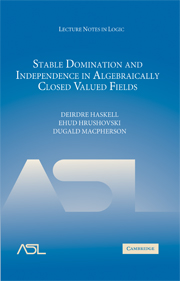Book contents
- Frontmatter
- Contents
- PREFACE
- CHAPTER 1 INTRODUCTION
- PART 1 STABLE DOMINATION
- CHAPTER 2 SOME BACKGROUND ON STABILITY THEORY
- CHAPTER 3 DEFINITION AND BASIC PROPERTIES OF StC
- CHAPTER 4 INVARIANT TYPES AND CHANGE OF BASE
- CHAPTER 5 A COMBINATORIAL LEMMA
- CHAPTER 6 STRONG CODES FOR GERMS
- PART 2 INDEPENDENCE IN ACVF
- REFERENCES
- INDEX
CHAPTER 2 - SOME BACKGROUND ON STABILITY THEORY
Published online by Cambridge University Press: 18 December 2009
- Frontmatter
- Contents
- PREFACE
- CHAPTER 1 INTRODUCTION
- PART 1 STABLE DOMINATION
- CHAPTER 2 SOME BACKGROUND ON STABILITY THEORY
- CHAPTER 3 DEFINITION AND BASIC PROPERTIES OF StC
- CHAPTER 4 INVARIANT TYPES AND CHANGE OF BASE
- CHAPTER 5 A COMBINATORIAL LEMMA
- CHAPTER 6 STRONG CODES FOR GERMS
- PART 2 INDEPENDENCE IN ACVF
- REFERENCES
- INDEX
Summary
We give here a brief preview of stability theory, as it underpins stable domination. We also introduce some of the model-theoretic notation used later. Familiarity with the basic notions of logic (languages, formulas, structures, theories, types, compactness) is assumed, but we explain the model theoretic notions beginning with saturation, algebraic closure, imaginaries. We have in mind a reader who is familiar with o-minimality or some model theory of valued fields, but has not worked with notions from stability. Sources include Shelah's Classification Theory as well as books by Baldwin, Buechler, Pillay and Poizat. There is also a broader introduction by Hart intended partly for non-model theorists, and an introduction to stability theory intended for a wider audience in. Most of the stability theoretic results below should be attributed to Shelah. Our treatment will mostly follow Pillay.
Stability theory is a large body of abstract model theory developed in the 1970s and 1980s by Shelah and others, but having its roots in Morley's 1965 Categoricity Theorem: if a complete theory in a countable language is categorical in some uncountable power, then it is categorical in all uncountable powers. Shelah formulated a radical generalization of Morley's theorem, weakening the categoricity assumption from one isomorphism type to any number less than the set-theoretic maximum. The conclusion is that all models of the theory, in any power, are classifiable by a small tree of numerical dimensions.
- Type
- Chapter
- Information
- Publisher: Cambridge University PressPrint publication year: 2007



